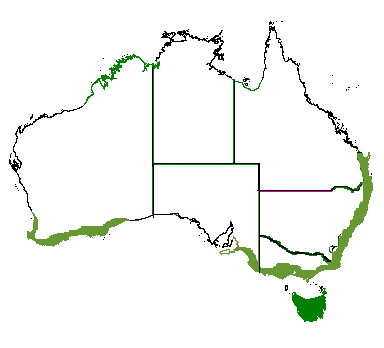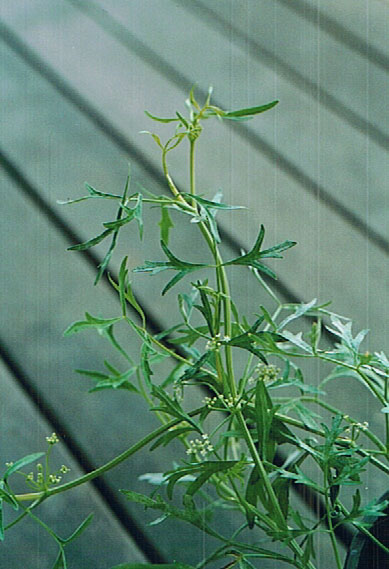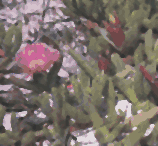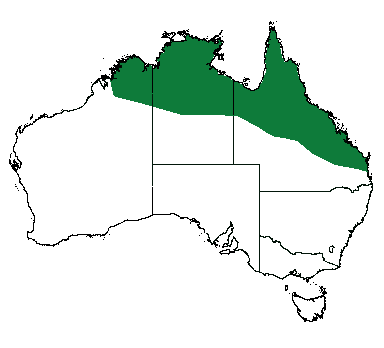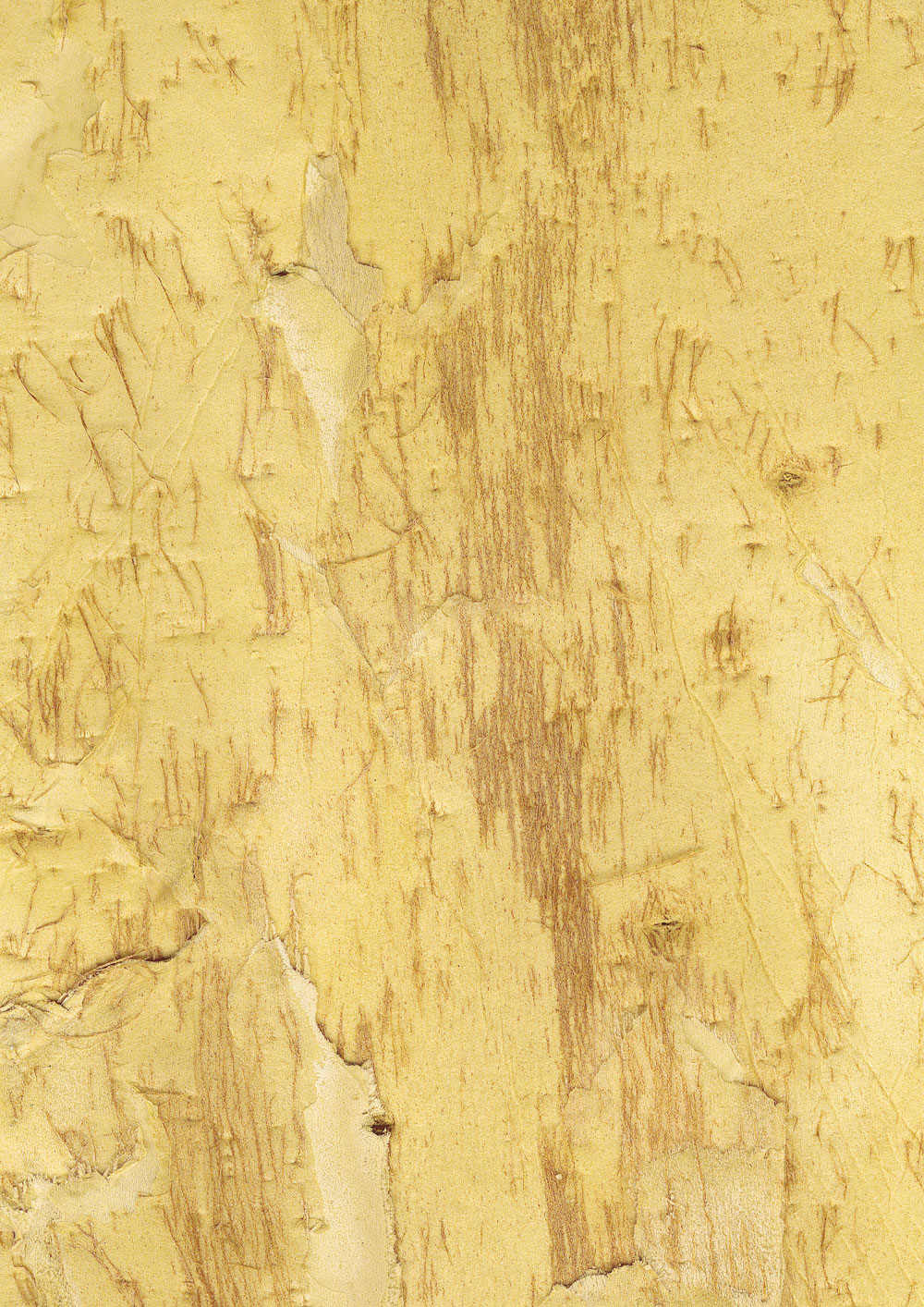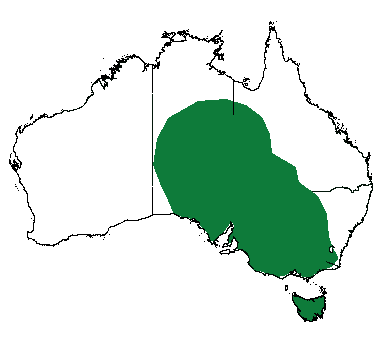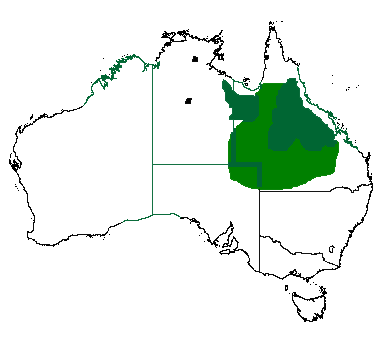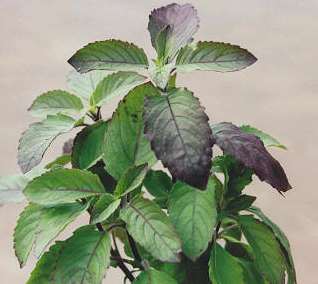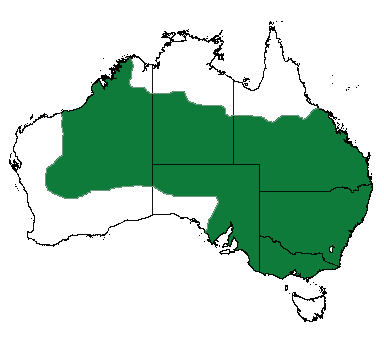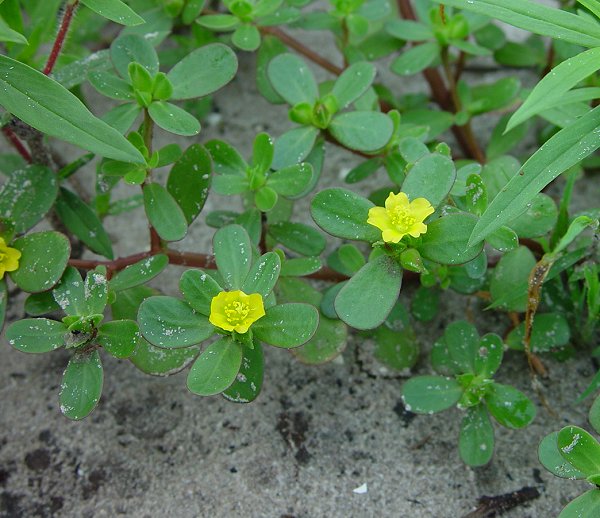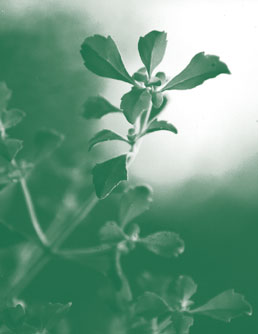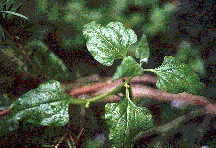|
||
| Carpobrotus spp | ||
| Ocimum tenuiflorum | ||
| Tetragonia tetragonioides | ||
|
|
|
Apium prostratum |
|
Sea celery, Sea parsley |
|
|
Family: |
Apiaceae alt umbellifereae |
General notes:Biennial or perennial herb. According to Tim Low, there are two very distinct Forms; coastal and inland, swampy region. No research into this species is known by the author. It was used by explorers and early settlers as a pot herb. Low states that the filiform variety is the most palatable. Low also suggests that the giant Apium insulare of the Bass Strait Islands could be worth investigation. Edible portion:Leaf Harvest period:Year round Yrs to maturity:1-2 Form:Low shrub or ground cover Natural Distribution/Growing conditions:Coastal regions from S Qld to eastern SA and S WA Climatic/microclimatic conditions:Sub tropical to temperate. Favours sunny positions Management reference:Leaf herbs. Prefers lighter soils and semi shade conditions, adequate water. Tolerates moderate frosts. Traditional Aboriginal Use:Unknown Density:As per parsley - 30cm x 30cm Yield at maturity:Unknown Supplied as:Fresh, dried, snap frozen? Harvesting:Hand Typical value adding:Use as one would parsley or celery leaves. Current purchasing price:Varies - $2 bunch Perceived demand:Low Research also:Apium annum Links
|
|
|
|
|
Backhousia anisata |
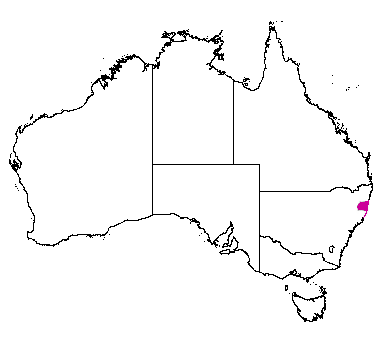 |
Aniseed myrtle |
|
|
Family: |
Myrtaceae |
General notes:Now rare in the wild. Extensive plantings in SE Qld and NNSW. The aniseed scented and flavoured leaf from a tall rainforest tree. A delicate aniseed flavour can be infused from the native aniseed leaf which is related to the lemon myrtle and behaves similarly in use. The delightfully subtle aniseed flavour is well suited for custard and ice-cream desserts, for rich meat sauces or as a tonic tea. Try it in marinades or dry powdered as a spice. Use in cooking as lemon myrtle, but remember the taste is decidedly aniseed. Tissue culture is being developed. Edible portion:Leaf Harvest period:Year round except when flowering Yrs to maturity:2-3 Form:Small to medium tree Natural Distribution/Growing conditions:Wet or dry rainforest, NNSW to SE QLD Climatic/microclimatic conditions:Sub tropical. Tolerates light frost. Management reference:B. citriodora. Traditional Aboriginal UseUnknown - believed it was not used as food Density:625/ha Yield at maturity:1.5kg Harvesting:Mechanical hedging or coppicing Supplied as:Fresh leaf, dried or dried and ground. Oil. Typical value adding:see B. citriodora Current purchasing price:$10-$20 dried leaf, $15-$25 dried and ground Perceived demand:High |
|
Backhousia citriodora |
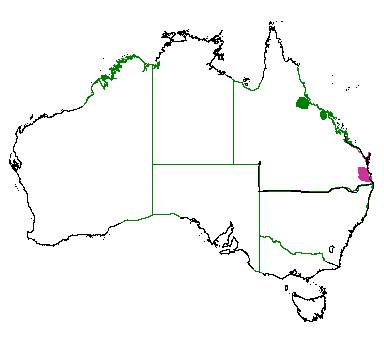 |
Lemon Myrtle |
|
|
Family |
Myrtaceae |
General notes:The leaves and stems of this rain forest tree exhibit a wonderful citrus flavour and aroma. Found on the east coast of Australia, the lemon myrtle leaf when crushed or infused releases a tempting combination of taste and aroma similar to a blend of sweet lemon grass, lemon and lime oils. Try lemon myrtle in soups, sauces, fruit stews and pickles or try sousing fish in hot vinegar and lemon myrtle. Lemon myrtle makes an excellent herb butter or custard, a refreshing tea or it can be added to breads. The lemon myrtle flavour can cook out with too much heat so add last and infuse or cover the simmering vessel to seal in the volatile oils. Probably one of the most successful bush foods to be incorporated into professional cookery. The lemon myrtle grows in semi-tropical and tropical rainforests and is the leaf of a beautiful tree. Edible portion:LeafHarvest period:Year round except when flowering. Yrs to maturity:2-3 Form:Medium tree to 15m Natural Distribution/Growing conditions:Tropical and subtropical rainforests in rich organic, sandy to heavy textured soils. Climatic/microclimatic conditions:Tropical-subtropical high rainfall. Management reference:Prefers acid to neutral soils. Some protection needed when young but full sun preferred for mature plants. It is wind hardy but prefers frost free areas. Irrigation needed in very hot dry conditions. Please note that to ensure adequate oil content, clonal selection of stock is recommended. Pest and disease free. Traditional Aboriginal UseUnknown, suspected nil Density:625/ha Yield at maturity:1.5 kg Harvesting:Mechanical hedging or coppicing Supplied as:Fresh or dry leaf or oil. Typical value adding:Whole or ground spice, tincture, oil, syrup, soft drink, useful food preservative, strongly antibacterial. The flavour of this remarkable leaf is that of lemon, lime and lemon grass. Use with all fish, seafood and white meats and vegetables. Make a lemon myrtle dressing, beurre blanc, mousse, sorbet. Sprinkle on meats and fish before grilling or over vegetables after steaming. Flavour butter or oil. Current purchasing price:$10-$20/kg Perceived demand:High but monitor plantings as there are a great number of trees going into the ground Reseach also:Backhousia myrtifolia (Cinnamon myrtle) From thr RIRDC Report
Cultivation of Native Food Plants in Southeastern Australia |
|
Carpobrotus spp |
|
Pigface |
|
|
Family: |
Aizoaceae |
General notes:The humble Pigface is in fact a delightful 'snack' which should have a wider use in the home, if not in commercial bushfood outlets. This is a creeping plant with highly succulent leaves and large purple flowers throughout the year. Edible portion:Purplish-red fruits, very tasty like salty strawberries or fresh figs. Some Aborigines tribes also ate the leaves as a substitute for salt. Harvest period:Summer and autumn Yrs to maturity:1 Form:Ground cover Natural Distribution/Growing conditions:C. glaucescens in Qld, NSW C. rossii (karlalla) in the south C.virescens in WA, C. modestus in SA and Victoria. Needs full sun, good in sandy, dry sites. Ideal for sand-dune stabilisation and road batter work Climatic/microclimatic conditions:Prefers frost free, hot and dry sites, salt resistant Management reference:As for any pigface - seem to flourish when neglected but perhaps soil modification and some mounding for drainage would encourage growth and flowering. Traditional Aboriginal UseFlowers, fruit and leaves eaten. Used as a purgative Density:Unknown - as a groundcover, you could perhaps plant at 3mx3m for a density of 625/ha (allowing for walkways) Yield at maturity:Unknown Harvesting:Hand Supplied as:Fresh Typical value adding:The leaves can be cooked. Would suit sale in punnets. Current purchasing price:$Unknown Research also:See Portulaca below. Also Sarcozona praecox of inland saline plains - a very similar plant, with edible fruit all year. Also - Disphyma crassifolium (Round-leaved pigface or rounded noon-flower) of southern beaches and plains, lacks succulent fruits. It has purple petals with white bases and less angular leaves, which are edible. Perceived demand:Not great at present. Perhaps suited to local promotion |
|
Melaleuca spp |
|
Paper BarkMost especially M. viridiflora (map), M. quinquinerva (Broad leafed paperbark) and M preissiana (Preiss's paperbark) |
|
|
Family: |
Myrtaceae |
General notes:All right - you can't eat it, but the market for paper-bark could be tapped as it is a 'simple' way for chefs and home cooks to create 'bushfood like' dishes (wrap fish in paperbark etc...) The Melaleuca tree has been used by Aboriginals for a multitude of purposes, from cooking, to carrying water, to providing shelter. The shedding paper-like bark is now used for wrapping foodstuffs prior to cooking. Portion used:Bark Harvest period:Year round Yrs to maturity:2-3 Form:Variable - small shrub to large tree Natural Distribution/Growing conditions:M. quinquinerva - along eastern seaboard from south of Sydney to Cape York, usually close to watercourses or swamps on a very wide range of soils. M. preissiana - coastal region of southwestern WA. Associated with floodplains of river systems but also found in drier conditions: Climatic/microclimatic conditions:M. quinquinerva - high rainfall areas in mild temperate to sub tropical areas. Frost sensitive. M. preissiana - high rainfall areas. Somewhat frost tolerant. Management reference: M. quinquinerva - prefers heavier textured soils M. preissiana prefers well watered heavier textured soils. Traditional Aboriginal Use:Various - M. quinquinerva especially was used in a number of medicinal roles. Density:3000/ha Yield at maturity:Unknown Harvesting:Hand Supplied as:Cleaned and rolled Typical value adding:Nil Current purchasing price:$Unknown Perceived demand:Medium and growing - great scope for promotion. |
|
Mentha australis |
|
River mint, Native mint |
|
|
Family: |
Lamiaceae |
General notes:Our native mints belong to the same family Labiatae (Lamiaceae) as the common spearmint (M. spicata). This family also includes other commonly grown oil-yielding plants such as basil, sage, rosemary, marjoram, lavender, pennyroyal and thyme. There are a number ofnative mints but they are rarely seen - being found in moist, shady areas near streams and waterways. Portion used:Leaf Harvest period:Year round Years to maturity:1-2 Form:Low-growing plant, readily sending out runners, or stolons, which develop new roots and shoots at the nodes. Under good growing conditions, stems will generally reach 1 m in height. Natural Distribution/Growing ConditionsThe mints will grow in a wide range of climates as shown by their popularity in home gardens all over Australia. Ideally, they require plenty of sun, growing best in the long midsummer days of the higher latitudes. For this reason, the Australian mint industry has developed mostly in Tasmania, particularly for oil production. Climatic/microclimatic conditionsIdeal growing temperatures for mint are warm sunny days (25°C) and cool nights (15°C). This is why, in the hotter climates, mint generally grows better in the more shaded areas of the garden. Management ReferenceMints do best in deep, rich soils of friable texture high in organic matter. The preferred pH range is from 6.0–7.5. A high water requirement means that soils must be deep and well drained while holding plenty of water. Mint can be propagated either vegetatively or by seed. Vegetative propagation is achieved by digging up plants in late winter–early spring and dividing them into runners with roots, then replanting. This will prevent the plants from becoming root-bound and prone to disease, ensuring strong, healthy plants for the new season. Mint requires a well-balanced nutrition program. Experience has shown that an annual dressing of animal manure will supply a good balance of major and minor elements. Care should be taken not to supply excessive amounts of nitrogen. Approximately 10 t/ha of good quality fowl manure applied midwinter will provide a reasonable nutrient program. If soil pH drops below 6.0 it may be necessary to apply dolomite or lime to raise the pH to the desired level. For maximum production, mint requires large amounts of water compared with other crops. To keep soil moist during periods of high evaporation, plantings should be irrigated at least twice a week. During the growth period in summer, plants can require up to 1500 mm of water. Weed control in mint crops is important to ensure that there is no contamination by foreign plant material at harvest. The selection of planting areas with low weed populations and a good kill of weeds prior to planting is important. Due to the lack of herbicides registered for use in mint in New South Wales, hand weeding is the most effective form of weed control. Mint rust is a serious disease that attacks the common mint species. The use of disease-free planting material and a sound rotation with other crops will help control it. Rust affects the leaves and shoots and if not controlled will quickly defoliate the plant. Plants can be flamed with a propane gas burner in spring to destroy diseased material before new shoots appear. Mint can be attacked by a wide range of pests. The main ones are loopers, leafrollers, slugs, snails and aphids. Traditional Aboriginal use:Unknown Density:Planting distance will vary with the type of mechanical equipment used to cultivate and manage the crop. A suitable row spacing is 50 cm with runners planted 10 cm apart within the rows. Using this system, three rows can be planted to a raised bed. As plantings develop, rows will become a continuous mass of mint. Yield at maturity:As per mint. Harvesting:The intensity of flavour and aroma in the mint plant is dependent on the level of essential oil in the plant. Oil content is at its maximum at the commencement of flowering. Harvesting is best done early in the morning when the plants are turgid and before any temporary wilting occurs. If mint is to be fresh it is best cut with shears or a sickle bar mower and bunched. It should then be kept moist, and cooled prior to marketing. Supplied as:Fresh or dried leaf, dried and ground leaf, oil Typical value adding:As for mint Current purchasing price:$25-$35/kg dried Perceived demand:Growing |
|
Ocimum tenuiflorumsyn Ocimum sanctum L.
|
|
Native thyme; Sacred Basil; Holy Basil |
|
|
Family |
Lamiaceae alt Labiatae |
General notes:This should really be called Native basil as its taste is much more of basil than thyme. If this herb has a drawback it is that the taste is not that different to conventional basil, thus losing some uniqueness. Edible portion:Leaf Harvest period:Year round. Flowers in summer Yrs to maturity:1-2 Form:Short shrub Natural Distribution/Growing conditions:Hot, arid inland regions - Qld, NSW, SA, NT and WA Climatic/microclimatic conditions:Low rainfall regions. Management reference:Leaf herb - most especially Mediterranean herbs. Traditional Aboriginal Use:Unknown Density:5000/ha Yield at maturity1.2 kg/plant Harvesting:Hand. Mechanisation as per other leaf herbs Supplied as:Fresh, dried, dried and ground Typical value adding:As for thyme or basil Current purchasing price:$[55] Perceived demand:Phelps (*) has quoted 100-300 kg pa demand in short term. Perceived demand:Growing |
|
Portulaca oleracea |
|
Pigface |
|
|
Family |
Portulacaceae |
General Notes:Portulaca oleracea is a species which occurs world wide and which has escaped from cultivation in parts of Australia. It is generally regarded a weed but, none the less, it is an Australian native plant. It is a prostrate herb with fleshy, reddish stems and thick, succulent leaves which are oval shaped and about 25 mm long. Small yellow flowers occur in the leaf bases. In inland areas dense colonies of the plant appear after rain. The main feature of the plant which raises its status above that of a common weed is its edibility. The species was well known to the early settlers who often used the juicy leaves in salads and, cooked, as a substitute for spinach. The seeds are also edible and are usually ground and baked into a damper. Pigweed is not often cultivated as an ornamental species due to its invasive tendencies. Those wishing to experiment with "bush foods" should find it easy to grow provided adequate moisture is available. It is best grown in well drained soils. Once established the leaves can be harvested at any time. P. oleracea can be grown easily from seed or cuttings. Edible portion:Fruit, seeds Harvest period:Year round for leaves Yrs to maturity:1 Form:Ground cover Natural distribution/Growing conditionsWidespread in all states except Tasmania. Climatic/microclimatic conditions:It will tolerate almost any climatic conditions. I have found, however, that a stem rot develops in my warm, moist climate. This may also be due to my soil not being sandy enough. Management reference:Nil - but it grows like a weed. Prefers very light, well drained soil and plenty of moisture. P. oleracea can be grown easily from seed or cuttings. Traditional Aboriginal use:Leaves and seed eaten Density:Unknown Yield at maturity:Unknown Harvesting:Hand Supplied as:Fresh leaf or dried seed Current purchasing price:NA Perceived demand:NCV |
|
Prostanthera spp P. incisa P. rotundifolia |
|
Cut leaf mint, Native mint |
|
|
Family: |
Lamiaceae |
General notes:Native mint is harvested from two of our native mint bush species. P. incisa is a very strongly flavoured leaf. Research is being undertaken into the anti-microbial properties of P. rotundifolia (Marie Gusak of the Food Technology Dept at the Victoria University of Technology, Werribee Campus.) Edible portion:Leaf Harvest period:Year round Yrs to maturity:1-2 Form:Low shrub - 1.5m H x 1.5m W. Small, fragrant leaves. Natural Distribution/Growing conditions:Coastal regions from S Qld to eastern SA and S WA Climatic/microclimatic conditions:Sub tropical to temperate. Favours sunny positions Management reference:Leaf herbs. Good drainage in full or part sun. Mulch. Traditional Aboriginal Use:Unknown Density:1500-2000 ha Yield at maturity:Mature bush can be pruned to yield 1-1.5 kg Harvesting:Hand or mechanised as for mint. Supplied as:Fresh or dried. Oil Typical value adding:A VERY strong flavour, closer to peppermint than garden mint, it can be incorporated into sauces, pesto, bunya nut butters or vinegar. Current purchasing price:$15-$25/kg Research also:Prostanthera rotundifolia Rounded shrub, 3m H x 1.5m W. Outstanding, profuse purple flowers in spring, fragrant leaves. Reasonably hardy for dry areas, good drainage and full sun without wind. Prune after flowering. Perceived demand:High |
|
Tetragonia tetragonioidesSyn Tetragonia expansa |
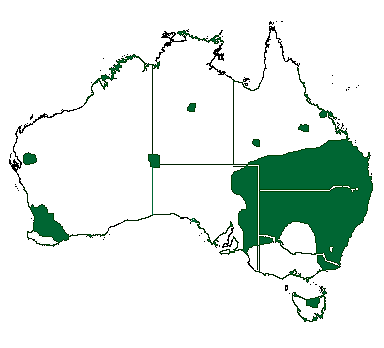 |
Warrigal greens, New Zealand Spinach, Botany bay greens |
|
|
Family: |
Aizoaceae |
General notes:PLEASE NOTE - Warrigal greens should not be eaten raw as they contain oxalic acid. The leaf should be boiled and the water thrown out. This is one of the world's hardiest vegetables, being tolerant of infertile soils, salinity and drought. In Australia, Warrigal Greens is commercially cultivated from Cape York to Victoria and South Australia. It is also grown as a self-regenerating groundcover/food crop in subtropical permaculture orchards. The large leafed coastal form is generally the most commonly cultivated type on the east coast of Australia. Some small-scale commercial bushfood growers are currently using T. tetragonoides as a source of cash flow while tree crops are maturing. It is either cultivated in market garden monoculture blocks or grown as an intercrop between existing tree rows. The editor has seen a reasonable variation in leaf size and thickness and would like feed-back from current growers on this. Edible portion:Leaf - please note need for blanching before use. Harvest period:Year round but plant can die off in summer. Yrs to maturity:>1 Form:Ground cover Natural Distribution/Growing conditions:Coastal regions from S Qld to eastern SA and S WA. Grows in a range of soil types from clay to sand but prefers friable loams with good organic matter levels. The probable optimum soil pH ranges from 6.0-7.5. Climatic/microclimatic conditions:Sub tropical to temperate. Favours sunny positions. Considered frost sensitive but has been observed tolerating frosts down to -3 o C for short duration. In temperate climates it is best suited for cropping in the warmer growing period from Spring to Autumn. Management reference:Although I have seen it stated that it is difficult to germinate from seed, in my experience (in the subtropical, frost free and wet conditions of SE Queensland) we have found it self seeds with remarkable ease. Stem and tip cuttings strike readily and may be the method of choice in order to ensure such characteristics as large leaves, low plant toxin levels, good flavour and vigour, etc. Avoid water stress. The watering regimen is comparable to standard leafy vegetable production. Depending on soil mineral content prior applications of ag-lime, natural gypsum or rock phosphate may be advantageous. Animal based manure fertilisers should not be used as a side dressing after the seedling has emerged. Prior green manure cropping, with annual legumes or grasses, should be considered as an alternative to animal manure based fertilisers. As with other crop vegetables there can be pests and diseases including white fly, cutworm caterpillar grass hoppers and green vegetable bugs. White fly infestation has been effectively controlled with potassium based soap sprays and cutworm controlled with Bacillus thurigensis biological spray applied at early stages in the life cycle of this caterpillar. Shadehouse production would likely give larger, more tender leaf. Traditional Aboriginal UseUnknown Density:Plant in rows 45cm apart and 30cm between rows. The editor has found that, given semi shade condition and moisture, it can go quite rampant. Approx 3000/ha Yield at maturity:Approximately 2 kg of leaf per sq.m of row culture can be harvested over a 3 to 4 month period. Harvesting:Hand. 4 to 7 kg of leaf can be harvested per hour, according to the efficiency of the harvester and quality of the crop. Preference should be given to the larger leaf variety although this can be difficult if purchasing stock or seed sight unseen. Try to harvest during the cooler time of the day. Wash, pack and dispatch leaf as quickly as possible after harvesting. Use cold storage at all post harvest stages, including during transit: Supplied as:Fresh or frozen. Preference given to entire leaf product, hand picked halfway along the leaf stem. 200g plastic punnets have been successfully marketed to conventional and organic green grocer type retail outlets.. The leaf is washed, graded and packed into cardboard banana boxes, lined with polyethylene bags to reduce drying in transit. Optimum temperatures for storage is generally 0 degree C with humidity of over 95%. NOTE: because of the requirement that this leaf be boiled before eating, labelling which gives explicit directions for use, including cooking, is essential Typical value adding:Used as a spinach or an attractive garnish or in salads (after blanching and refreshing in ice water). Try a macadamia nut oil, native mint and Warrigal green Aussie pesto with roasted macadamia nuts for texture. Current purchasing price:$6-$10/kg premium grade (delivered to wholesale bushfood specialists). Perceived demand:Medium |
|
|
|
|
